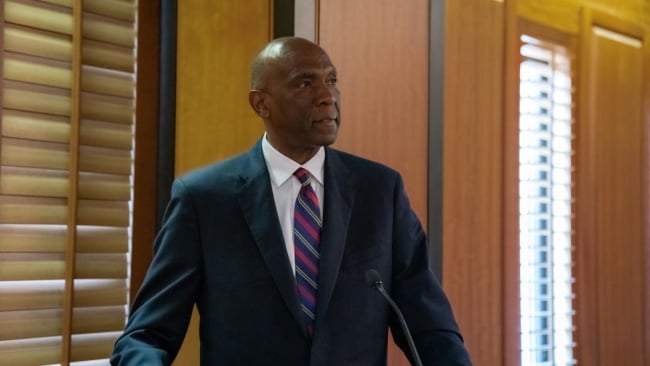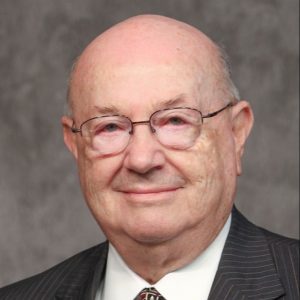You have /5 articles left.
Sign up for a free account or log in.

The termination of Bishop State interim president Lawrence Brandyburg has raised larger questions about turnover within the Alabama Community College System.
Bishop State Community College
Frustrations with Alabama Community College System leaders came to a head among state lawmakers in Mobile this summer after the firing of the interim president at Bishop State Community College, Lawrence Brandyburg. The firing in June raised concerns about frequent leadership turnover at the historically Black community college and within the system as a whole.
Some policy makers believe the system has hemorrhaged presidents in recent years because of micromanaging by the system chancellor, Jimmy Baker. System leaders say the repeated changes in leadership on various campuses preceded Baker’s tenure and that his administration has worked to address the problem.
A bipartisan group of 10 state lawmakers held a press conference in June and wrote to Governor Kay Ivey, who is also the president of the system’s Board of Trustees, to express “outrage” about Brandyburg’s abrupt dismissal. He was terminated after just over a year in his role. The group praised Brandyburg for cultivating “a cohesive relationship with business and industry, K-12 schools, and community organizations” and called for an investigation and a meeting with the board regarding his departure.
“We have grave concerns about micromanagement and leadership changes that will hamper the community’s efforts to rebuild confidence in Bishop State,” the letter reads. “It is troubling to witness the recent barrage of leaders that have been at the helm of the historically Black community college.”
Brandyburg’s termination “was the straw that broke the camel’s back,” said Barbara Drummond, one of the state representatives who signed the letter. “It points to a deeper problem.”
Bishop State has had six acting, interim and permanent presidents since 2015, not including Olivier Charles, the new president who started last month. The turnover is hardly an isolated case within the system.
Almost half of the 24 campuses in the system have had at least four leadership changes in the last decade, including Bevill State Community College, Northwest-Shoals Community College and Gadsden State Community College, according to Lagniappe, a local weekly newspaper.
Ebony Horton, a spokesperson for the system, said rampant leadership turnover at Alabama community colleges preceded the current chancellor and is a common problem at community college systems across the country. She noted that nine of the 24 colleges had interim presidents when Baker took his position five years ago. All the colleges in the system now have permanent presidents in place, she said.
“This is quite an achievement and it did not happen by accident,” Horton said in a statement to Inside Higher Ed. “It was the result of an intense, focused effort to recruit the best possible leaders for every institution. Our System’s college presidents are committed to serving their colleges for the long-term and they have a proven track record of success in education and/or business. Having a full slate of permanent presidents in place brings a higher level of stability and performance to our institutions that is good for students, faculty and our entire state.”
Drummond isn’t convinced the pattern of short-term presidential tenures is over, despite the new hire at Bishop State.
“It was never our concern who they put there,” she said. “It’s how they let them go.”
James Brandyburg, the brother and attorney of the fired interim president, told Lagniappe that his brother was laid off after refusing to promote his special assistant Frazier Payne to executive vice president in March at the chancellor’s request. He was concerned that Payne, who held only a bachelor’s degree, was underqualified for the role, Brandyburg said, noting that Payne was made special assistant to the chancellor shortly after he was denied the initial promotion.
Local community members in Tuscaloosa were also upset by the replacement of Brad Newman, president of Shelton State Community College, in February after less than a year in the role. Leaders of local businesses, churches and advocacy groups, including the Tuscaloosa NAACP chapter, spoke out against the unexplained decision at a meeting on his behalf that month, according to WBRC, a Fox-affiliated television station in Alabama.
Shelton State has had nine interim and permanent presidents in the last 10 years, not including Chris Cox, who became the interim president after Newman’s departure and the permanent president in June.
“The problem is not the president’s position,” John Covington, owner of Chesapeake Consulting, a local firm, said at the meeting, according to WBRC. “There’s something else wrong or you wouldn’t be turning over all the presidents. What you have is a culture problem.”
A longtime former staff member at the system, who said their position at the system office was terminated without explanation, said the rate of turnover among presidents appeared to increase when the current chancellor came into his position. The employee, who asked to remain anonymous, said Baker is known for putting an emphasis on workforce development and letting go presidents who don’t comply with his vision.
“If you don’t go along with whatever his agenda is, he will get rid of you,” the employee said.
The Ripple Effects of Leadership Churn
Horton said the Alabama Community College System is simply part of a national, long-term trend.
“High turnover among community college presidents is not unique to Alabama,” Horton said. “As Inside Higher Ed and other publications have noted, presidential turnover at community colleges has been a challenge across the country for a decade.”
The length of college presidencies have been decreasing over all. The average tenure of a president in their current job was 6.5 years in 2016, down from seven years in 2011 and 8.5 years in 2006, according to the most recent American College President Study by the American Council on Education. The average tenure for a community college president was slightly shorter, at 6.2 years.
Tara Zirkel, a director of strategic research with a focus on community colleges at EAB, an education consulting firm, said that the pandemic also contributed to a high rate of turnover at community colleges across the country.
“Community colleges have hit an impasse driven in large part by a combination of the retirements that occurred at the start of the pandemic (some of which were incentivized as a cost saving measure) and the overall great resignation,” Zirkel said in an email. “When large numbers of people retired in the early days of the pandemic no one was predicting the workforce trends that we are seeing now. EAB estimates the community college sector has seen a 13 percent decline in workforce, which absolutely includes senior leadership.”
Having to seek and hire new leaders so frequently, especially at a time when candidate pools are smaller and candidates themselves more selective, can put strain on a community college.
“Executive searches are a challenge during the best of times as they divert time and resources away from other tasks,” Zirkel said. “The process can also stifle progress on important initiatives because people want to give the new leader the opportunity to provide strategic input before critical decisions are made.”
Bradley Byrne, president of the Mobile Area Chamber of Commerce and the chancellor of the Alabama Community College System from 2007 to 2009, said he worries that turnover at Bishop State could deter students from attending and ultimately graduating from the institution, exacerbating workforce shortages as industries such as aviation and high-tech manufacturing grow in the area.
“Anytime you churn leadership, it’s not good for the organization, no matter what the organization is,” he said. “Bishop State Community College is the main postsecondary provider of training and skills, and we are an extremely dynamic economy down here. We have to allow them to produce a continuous stream of graduates at a pretty high level, and it impedes the ability of the organization to deliver on that if they’ve got this leadership churn.”
Byrne said during his time as chancellor, there was a “dramatic amount of turnover” among presidents because of leadership scandals that shook the institution. More than a dozen community college officials were convicted of crimes including fraud, money laundering and corruption.
The turnover was “constant,” but he tried to quickly install permanent presidents, he said.
He’s hopeful about the new president and praised system leaders for his swift appointment a month after Brandyburg’s departure.
“I’ve got no complaints about that,” he said. “I think going forward, the test is whether the leadership stands behind Mr. Charles as a permanent president. I want to see the system back him up, pay him to do what he needs to do and for them to support him as he’s interacting in this very positive way with the community … If they’ll stick with him and don’t have any more of this churn, I think we’ll be in a great position down here.”
Drummond, the state lawmaker, also has concerns about the effect of turnover on workforce development as well as the potential ripple effects on faculty members and students.
“It’s not only the workforce,” she said. “Can you imagine what the morale is of those who are educating the students at Bishop State? It starts with the staff, it goes to the students, then it goes through the community and then it goes to the industry.”





